Essential Ski Touring Gear: Types and Materials Explained
Get the right gear and know-how for safe, enjoyable ski touring adventures in the backcountry!
GEARSKI TOURING
Jan
11/9/202410 min read
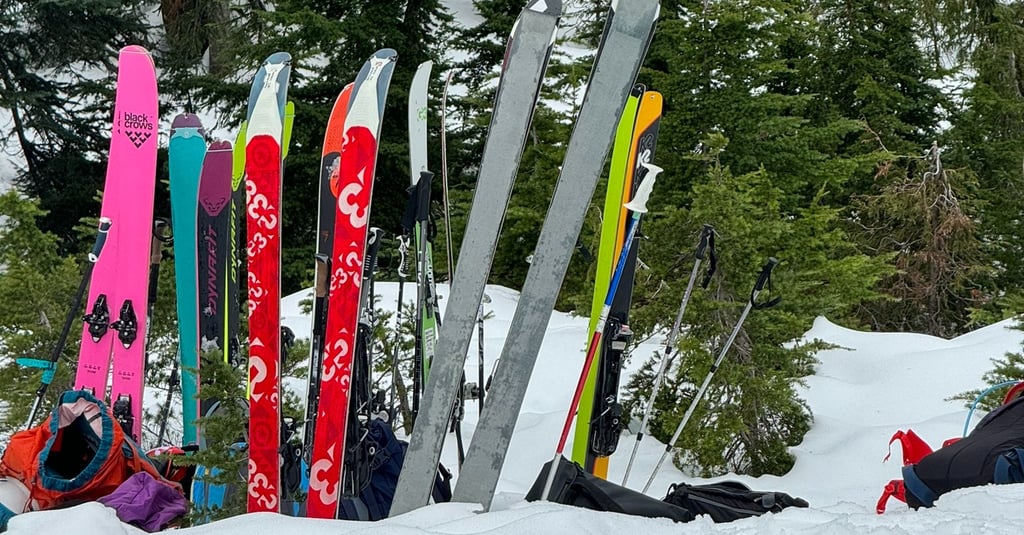

Ski Touring Gear: Essentials and Optional Items
Since you found this post, you’re likely aware—or at least guessing—that ski touring requires different gear compared to downhill resort skiing. There are essential pieces of equipment that make ski touring possible, allowing you to trek uphill and then ski down. Then, there are additional items that, while not strictly necessary, make the experience more enjoyable, comfortable, and efficient.
Recently, I had a funny conversation with a fellow outdoor enthusiast about her rough start with ski touring. She dove into it without much knowledge of the various types of gear, which led to some tough lessons. On one of her first trips, she used alpine boots with frame bindings, not realizing that ski touring boots are designed to allow ankle movement, imitating a walking motion. Alpine boots, on the other hand, have a rigid spine and offer no ankle flex. She powered through the day with serious blisters, only to realize later that it wasn’t the sport but her choice of gear that made the experience so uncomfortable. She made it through, but she learned the hard way!
Since you’re already here, make sure you read this article to the end to choose the right gear and setup for yourself. 😉
It’s not just about functionality—it’s about comfort too, which you’ll definitely want to prioritize if you’re out there all day or even on multi-day trips. And, of course, don’t forget about safety; choosing durable, reliable materials is crucial in the challenging environments you’ll face in the backcountry.
Ski Touring Skis: Types and Features
Bindings: A Key Component of Ski Touring Gear
While you could use downhill skis for ski touring, your downhill alpine bindings wouldn’t work—they’d make touring highly impractical and uncomfortable. Choosing the right bindings is a critical part of setting up your ski touring gear, and it’s closely tied to your ski choice. Bindings not only connect you to your skis but also heavily influence your performance and safety. The main types of bindings used in ski touring are frame bindings, tech bindings, and hybrid (shift) bindings. The essential factors to consider when selecting bindings are weight, durability, ski performance, and safety, especially based on the DIN ISO standard for safety release.
Touring Boots: Comfort and Control
As you might remember from my story at the beginning of this article, finding the right ski touring boots comes down to two main factors: functionality and comfort. You’ll want boots that are compatible with your chosen binding type and, ideally, versatile enough to work with any future ski setups you might consider. Most importantly, they need to feel comfortable, especially if you’re planning on long touring trips. 😉
Climbing Equipment: Skins and Crampons
How are you supposed to walk uphill if your skis keep sliding back? That’s where those sticky strips—called skins—come in. Skins attach to the bottom of your skis to provide traction while climbing, and there are several types to choose from, made from materials like mohair, nylon, or a hybrid of both. This is one essential piece of gear where I’d recommend investing in a reliable, high-quality brand. Why? Because without functional skins, the only direction you’ll be able to go is down, which is a problem if you’re already up in a bowl and need to climb back out.
Nylon skins are known for their durability and resilience, making them great for rugged conditions. Mohair skins, on the other hand, are lighter and offer better glide on flat terrain, which is helpful for smooth transitions when you’re switching between uphill and downhill sections. Hybrid skins combine the benefits of both, balancing durability with glide—perfect for varied alpine conditions.
Proper installation and maintenance of your climbing skins are essential for them to work effectively. Skins should be as wide as the rubber strips on your skis, but not cover the edges, allowing your ski edges to grip the snow while keeping maximum skin coverage. New skins typically come with a cutting tool to adjust them to your ski’s width, and the process is straightforward. If you’re not confident in cutting them yourself, bring them to your local ski shop where they can do it for a small fee. Be sure to treat them with skin wax to preserve the adhesive and make them easier to apply and remove. During climbs, keeping skins free from snow build-up will also help maintain grip.
Safety Gear: Essential Items for Ski Touring!
Safety equipment is an essential part of any touring setup—absolutely mandatory when venturing into the backcountry. The core safety items include avalanche transceivers, probes, and shovels, each playing a crucial role in risk management.
Avalanche transceivers, or beacons, are essential devices worn by skiers to help locate someone buried in an avalanche. They emit a radio signal, allowing rescuers to pinpoint a victim’s location within a specific range. Modern transceivers use advanced digital technology to provide a quick and accurate response in emergencies.
Probes are typically made from lightweight aluminum or composite materials and are essential for confirming the exact location of a buried person. Available in different lengths, longer probes are advantageous for deep snow. The material affects both their weight and durability, which is critical as they need to withstand rough conditions during search missions. When paired with a transceiver, probes significantly increase the efficiency and success of rescue efforts by allowing rescuers to locate victims quickly.
Shovels are also vital for ski touring safety. Usually crafted from durable but lightweight materials like aluminum or reinforced plastic, they’re used for digging out buried victims or even creating emergency shelters. Shovels must be sturdy enough to handle packed snow but compact enough for easy storage in a ski pack. Many models are collapsible, making them convenient to carry without adding too much weight.
Together, these pieces form a comprehensive safety system that ensures preparedness and effective response during critical situations in the backcountry. Taking an avalanche safety course is highly recommended to learn how to use this gear effectively and practice rescue simulations in a controlled environment.
Wrapping Up
Ski touring is a rewarding yet challenging experience that requires specialized gear designed for both safety and performance. Whether you're a beginner exploring easier routes or a seasoned skier tackling steep descents, choosing the right equipment can make all the difference. From lightweight touring skis and tech bindings to specialized boots and skins, each piece plays a vital role in ensuring you can move comfortably and safely. And don't forget—safety gear like avalanche transceivers, probes, and shovels is absolutely non-negotiable for backcountry travel.
Investing time in selecting equipment that suits your needs, skiing style, and terrain will transform your touring experience, making every climb and descent more enjoyable and secure. As you venture into the mountains, always prioritize reliability, comfort, and safety in your gear—because a well-prepared skier is a happy skier.
And remember, you can ski in your touring setup, but you can't—or at least shouldn't—tour in your downhill setup. 😉 The best gear is useless without the knowledge and skills to use it.
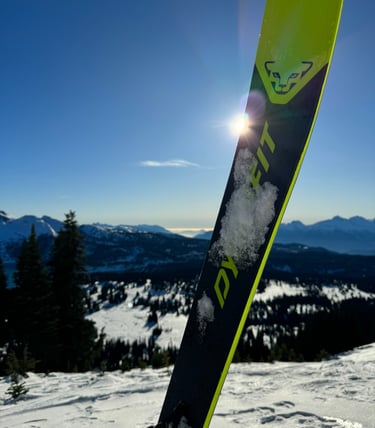

Choosing the Right Ski Length:
Ski length impacts maneuverability and stability. Shorter skis offer better control and are ideal for navigating tight spaces, while longer skis provide stability and speed on open terrain. To select the ideal length, consider your height, weight, and skill level. Advanced skiers may opt for longer skis for high-speed descents, while beginners often find shorter skis easier to control.
Width:
Ski width is crucial, with touring skis typically ranging from 70mm to 120mm at the waist. Narrower skis are better for firmer snow and technical ascents, allowing quick edge-to-edge transitions. Wider skis excel in powder and softer snow, making them ideal for off-piste adventures.
Shape:
Ski shape plays a significant role in performance. Many touring skis have a rockered tip, enhancing floatation in deep snow and aiding turn initiation. Some models also feature a tapered tail, making them more efficient for backcountry navigation and adaptable to various snow conditions.
Categories of Touring Skis:
- Alpine Touring Skis focus on downhill performance, combining strengths for aggressive skiing with uphill efficiency.
- Light Touring Skis prioritize weight savings, making them ideal for longer backcountry trips.
By understanding these factors, you’ll be well on your way to choosing the best ski touring setup for your goals and terrain.
When it comes to ski touring gear, the skis themselves are, of course, top of mind. Touring skis come in various lengths, widths, and shapes, tailored to specific skiing styles and terrain. Before you dive into shopping, consider a few key questions to clarify the type of skis that best suit your needs:
1. What’s my primary activity? Do you plan to ski more or focus on backcountry travel? Are you looking to cover long distances or hike up and ski down challenging terrain?
2. What’s my experience level? Are you an experienced skier, or are some lines still challenging? Do you ski aggressively, or do you prefer taking it easy and carving your own path?
3. What’s my budget? While budget is always a factor, don’t sacrifice functionality or safety. If anything, go with a lesser-known brand rather than compromising on quality.
Frame Bindings
Frame bindings are the oldest type but are becoming less popular due to their weight and robust frame, which lifts with each step.
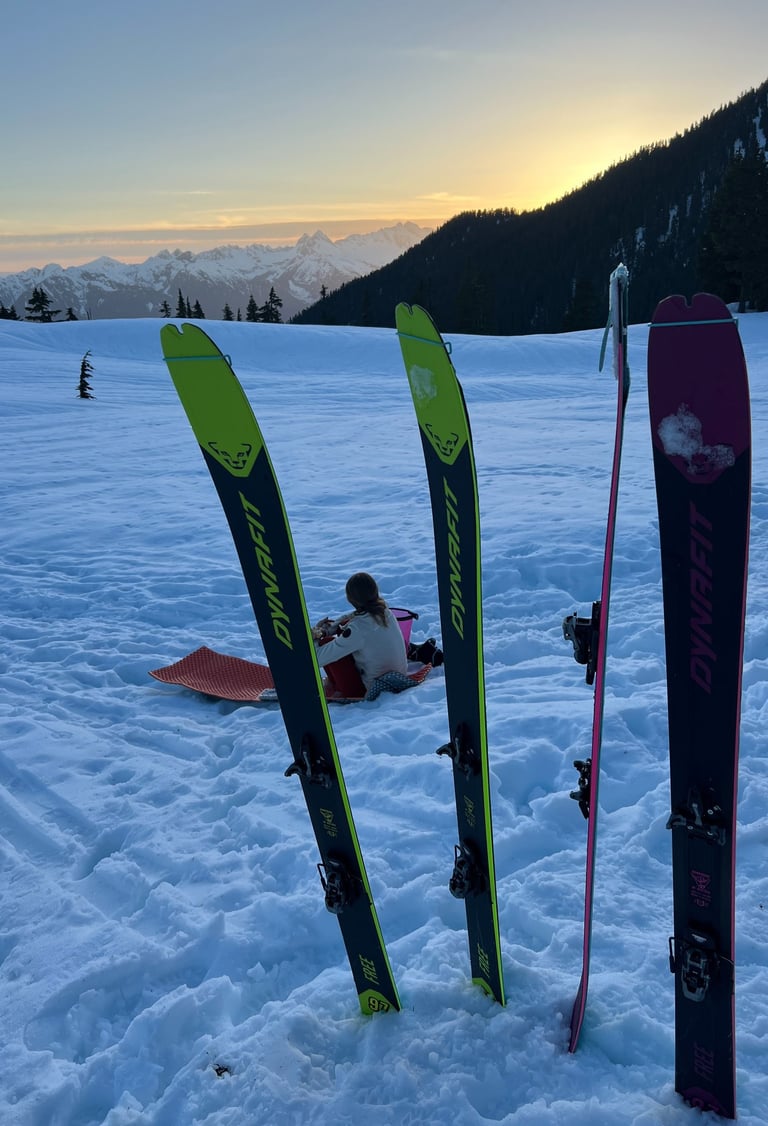

Hybrid Bindings
Hybrid bindings, the newest in the ski touring scene (first released in 2018), combine the best of both tech bindings’ lightness and alpine bindings’ reliability for more aggressive skiing. These bindings feature a pin toe for efficient foot movement in walk mode, paired with a frame-like heel for stability on challenging descents.
Tech Bindings
Tech bindings are the lightest of the options, specifically designed for backcountry enthusiasts who value long-distance touring and a non-aggressive style on soft snow. Unlike frame bindings, tech bindings stay attached to the skis in walk mode, with only the toe piece following your foot movement. They feature two pins at the toe and two at the heel that connect to holes in your backcountry ski boots, keeping only the toe attached in walk mode (just make sure your boots are compatible with tech bindings 😉).
Features:
Strong downhill performance
Reliable release settings that comply with the DIN ISO standard, staying locked during aggressive descents but releasing when needed during falls
More affordable than tech or hybrid bindings
Cons:
Heavier weight – not ideal for long-distance tours since you’re lifting the entire binding with each step
Reduced ski flex – frame bindings can limit the ski’s natural flex, impacting performance
Slower transitions
More prone to icing up
Features:
The lightest and smallest binding type
Fastest transitions – experienced backcountry skiers can switch from walk to ski mode and click in without stepping out of the bindings
Cons:
Reduced downhill performance – they can sometimes release prematurely or from vibrations on icy, firm groomers
Limited safety features – not all have DIN certification, so look for models with this standard if you need adjustable release settings based on skier weight. They have a unique ISO norm different from frame or downhill bindings and aren’t recommended for resort groomed slopes.
Boot compatibility – only works with boots with a pin toe and heel system
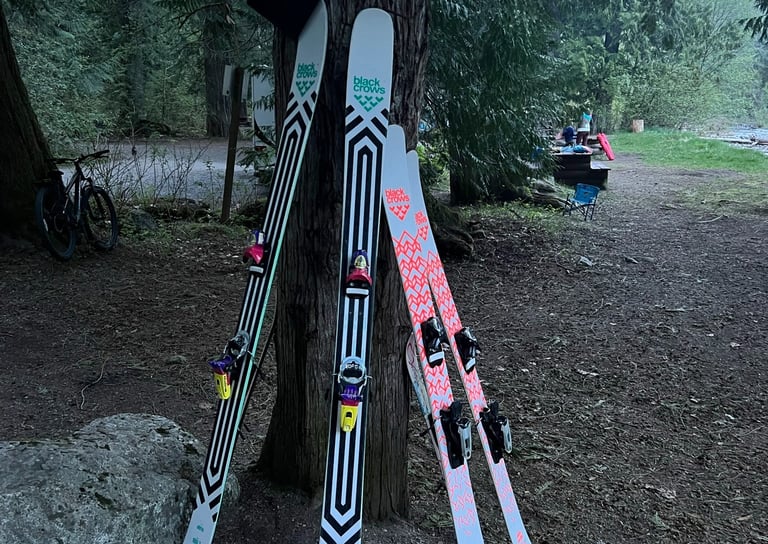

You can offset some drawbacks of tech bindings by choosing a model with both DIN and TÜV certification, like the Dynafit ST Rotation. This certification means it can release as reliably as a traditional alpine binding, although it comes at a higher price.
Features:
Lighter than frame bindings but heavier than tech bindings
Better downhill performance than tech bindings, though not quite as robust as frame bindings
Cons:
The most expensive option
Slower transition than tech bindings
Boot compatibility – requires boots with a pin toe system
While hybrid bindings might seem ideal if you have the budget, remember that the right choice depends heavily on your goals. For long-distance traverses, frame or hybrid bindings will cost you more energy with each step. But if you’re looking to ascend and ski down intense terrain, prioritizing safety and reliability with frame or hybrid bindings is worth it.
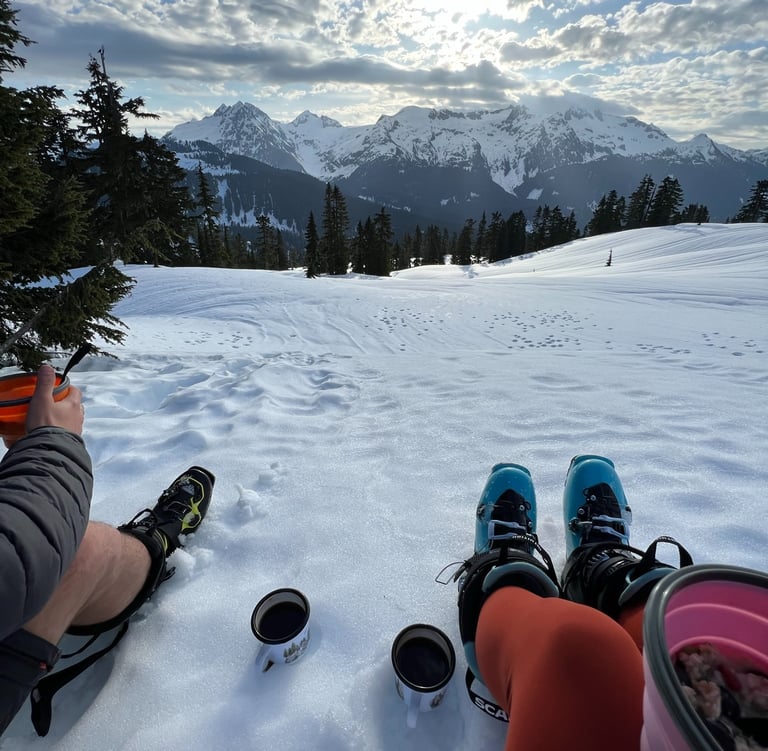

When choosing boots, think back to your intended use and skiing style. If you’re focused on longer distances, lighter boots can make the uphill sections easier, though they might sacrifice some stiffness and control for downhill performance. On the other hand, if you mostly ski in the resort but venture into the backcountry occasionally or prefer aggressive skiing with jumps and speed, heavier boots with higher stiffness and four buckles might be a better choice—they’ll provide better control and safety for downhill.
Touring boots are the one piece of gear where an in-person fitting is essential. Most ski shops offer fitting sessions, and I highly recommend booking one. Skipping this step could throw off your budget, especially if you end up needing adjustments later. At the fitting, you’ll explain your skiing goals and try on various types to find the best fit. Many shops also offer boot customization, like “punching” (heating and widening the hard plastic shell) and molding (heating the inner liner) to ensure a snug yet comfortable fit tailored to your feet.
Finally, check the compatibility of your boots with your bindings. If you’re opting for tech bindings, you’ll need boots with a pin toe and heel system. Frame bindings are compatible with a wider range of boots, but watch out—some pin-toe boots, like the Dynafit Hoji Pro Tour, lack the necessary toe lug for frame or alpine bindings and are only compatible with hybrid or tech bindings. Make sure everything fits together to avoid surprises on the mountain!
In addition to skins, ski crampons can be invaluable for icy conditions where skins alone don’t offer enough grip. Crampons attach to your skis, adding extra traction and stability on steep, hard-packed slopes. When choosing ski crampons, make sure to select the right size and configuration for your bindings. Effective use of crampons means positioning them properly according to the terrain and securing them well before attempting steep ascents.
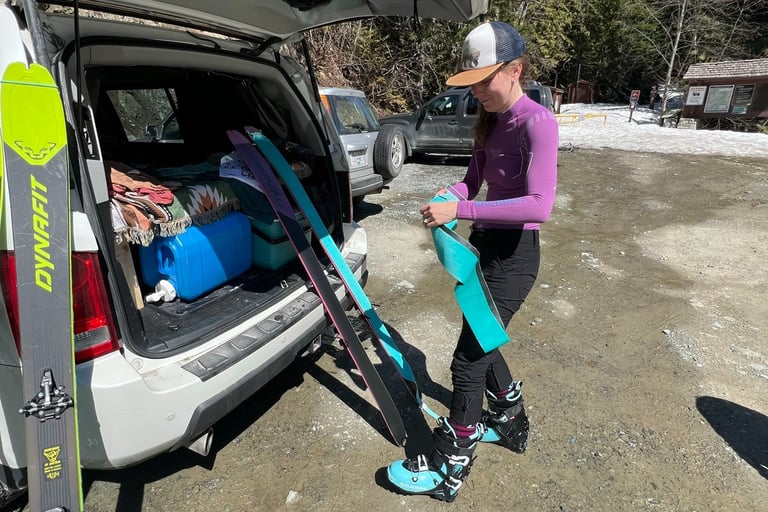

Explore
Inspiring mindful adventures in nature sustainably.
Join the wandering Community
© 2024. All rights reserved.
by @wanderingintwo
